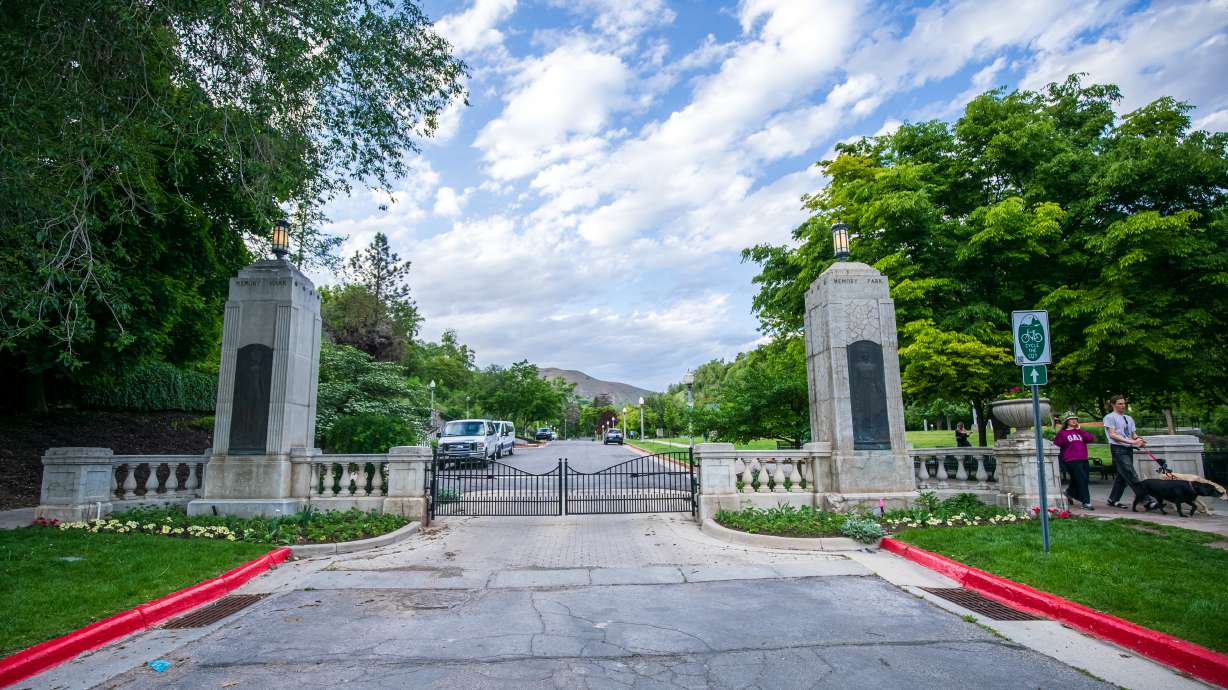Estimated read time: 5-6 minutes
This archived news story is available only for your personal, non-commercial use. Information in the story may be outdated or superseded by additional information. Reading or replaying the story in its archived form does not constitute a republication of the story.
SALT LAKE CITY — With an average of 4.8 out of 5 stars, Memory Grove Park is the highest-rated park in Salt Lake City on Google Reviews — and Brandy Strand says it's easy to see why it's so beloved.
Nestled between the Utah Capitol and the Avenues, you'll see people walking or running along the path leading into City Creek Canyon any given day. Families come here to picnic or let their children run around, while dogs often splash around the creek as it flows toward the city. Its charming aesthetic makes it a popular spot for weddings, events and general portrait photography.
Yet despite many of these happening — sometimes all at once — just blocks from a bustling downtown, the park is almost always calm and reverent.
"Once you step through the gate of the park, it becomes quiet and tranquil," says Strand, director of Preservation Utah, which operates out of a historic building in the park and helps the city maintain some of its features.
It's perhaps why Memory Grove became what it also is: a memorial to Utah soldiers who have died in battle. Today, visitors can find moments dedicated to Utah soldiers who died during several wars over the past century.
This wasn't always the case, though.
Memory Grove Park's origin
Early settlers created some of the state's mills and quarries within City Creek Canyon, but those began to die down by the end of the 19th century, according to William Love, who wrote about the park for Utah Historical Quarterly in 2008.

That's when Salt Lake City swooped in. City leaders acquired the land, including a stable owned by asphalt contractor P.J. Moran, in 1902 and quickly passed a resolution to create a park on land toward the mouth of City Creek Canyon. Per the city, this was mostly in response to the growing need for park space as the city went through a population boom in the early 20th century.
But city leaders also didn't know what they wanted the park to be, so it sat mostly undeveloped for about two decades.
"After all that building in Salt Lake, this space was still very much open," Strand explained.
The Great War changed everything.
Love wrote that Service Star Legion's Utah Chapter met in April 1920 to discuss building a war memorial less than two years after the war ended. It had Salt Lake City's undeveloped park space in mind, presumably because of its reflective nature.
This sparked about four years of planning and fundraising to build such a memorial, led by Mrs. E. O. Howard, the mother of a soldier lost in action. Visitors may recognize her name from "Gold Star Hill," another monument found in the park with her name on it.
Memory Grove Park officially opened on June 27, 1924, in an emotional ceremony overseen by Utah Gov. Charles Mabey. Gold Star families wept as a bronze tablet with the names of hundreds of Utah soldiers who died during the war was unveiled, the Salt Lake Telegram reported that day.
The Deseret News reported that the solemn ceremony "left many a moist eye."
"May this Memory Grove be to us an ever-present reminder of the good and faithful sons of this commonwealth and teach us the spirit of sacrifice and devotion to our families, or community and our country, and all mankind," Rabbi Adolph Steiner reportedly said in his invocation.
Ongoing expansion
It appears that The Pagoda, a large marble structure, replaced the tablet referenced in newspapers as the park's nod to fallen World War II soldiers. It dates back to the mid-to-late 1920s and was completed in 1932.

By then, other military groups wanted a space to honor fallen soldiers in the park.
"Other community groups wanted that same level of tranquility to be able to reflect," Strand said. "That's when we started to see the addition of other monuments."
A monument dedicated to fallen 145th Field Artillery soldiers was dedicated in 1927, as the Great War monument was completed. Several monuments have been placed since then. Of those, the park's Meditation Chapel is probably the park's most recognizable feature.

Preservation Utah refers to the tiny pink marble chapel as "the heart" of Memory Grove.
Ross Beason Sr. and Elvera Beason commissioned it shortly after World War II to honor their son, Ross Beason Jr., and other Utahns who were left missing in action after the war. It was dedicated in 1948 with a ceremony that brought an estimated 10,000 people, including Air Force Gen. Carl Spaatz.
The park today
Strand peers out her office window to see about five people by the Meditation Chapel. It's closed most days, but Preservation Utah offers frequent tours during the summer. Many weddings and events are held in Moran's historic stable, now called the Memorial House.
She doesn't know if it'll house any more monuments because that's ultimately up to the organizations that sponsor them and the city, but she says there will always be an effort to preserve the existing ones.
The chapel went through a renovation about 25 years ago after it had fallen into disrepair, while there were big cleanups after the 1983 flood and 1999 tornado, too.

And as the city and region grow, Strand knows visitors will find something to love at Memory Grove.
"(It's) the best-kept secret in Salt Lake City that we don't want to be a secret," she said. "I highly encourage people to come and experience the history."










